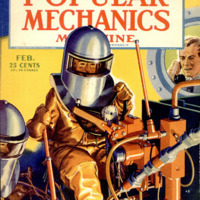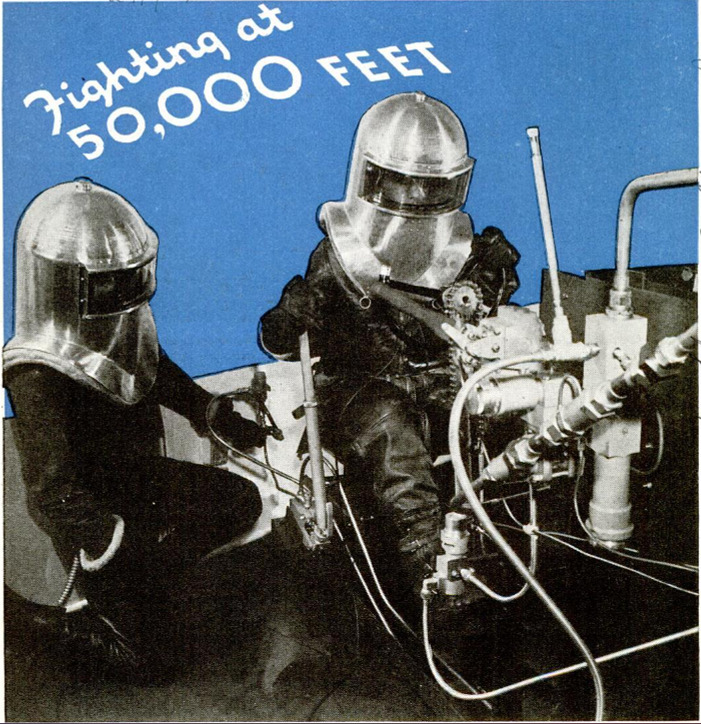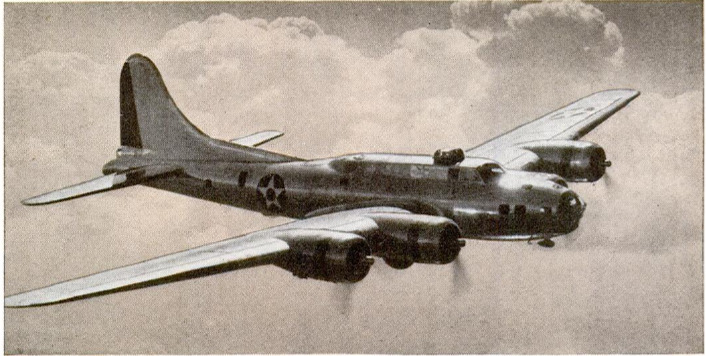AMERICAN Boeing-built Flying Fortresses that bomb from the upper limits of the troposphere are revolutionizing aerial warfare in Europe. Bombs are dropping from the blue sky, from airplanes so high that they are nearly out of sight and hearing of ground observers. From 30,000 feet a battleship looks the size of a pinhead. For even larger targets the bombardier six miles up must squint through a telescope to find his mark. Yet at such altitudes the Flying Fortresses are carrying more bombs faster, farther and more safely and are dropping them more accurately than can low-flying airplanes of more limited performance. American designers who have been laughed at by foreign experts for going to “unnecessary heights” are now being vindicated. Having pushed the war up to 30,000 feet the same American designers are now striving for effective operation at the 35,000~ and 40,000-foot levels. The battle zone of the future, they believe, may ultimately climb to 50,000 or 60,000 feet, ten miles or more above the earth. At such heights the aviators may wear queer-looking lightweight pressure suits and helmets. Breathing oxygen, they will talk in high squeaky voices into their radios. They may have to learn new ways to fight, because airplanes, bullets, and bombs all operate strangely in the cold, thin air. The advantages of high flight, aside from operating economies and extra speed, are many. A bomber, for instance, is above most of the weather and thus becomes a steady platform for accurate bomb sighting. Antiaircraft fire is extremely inaccurate even at present ceilings, Not many pursuit planes can climb as high as the altitudes at which the Flying Fortresses now operate. On the other hand the standard temperature at 35,000 feet is 67 degrees below zero. Air pressure is 3.45 pounds per square inch, less than a quarter of the pressure at sea level. There is not enough oxygen to sustain life. All sorts of troubles related to these conditions had to be vanquished before 30,000-foot operation became dependable. The same problems are worse at 35,000 feet, the next step up. For one thing, the moisture of the pilot’s breath condenses on the windows and freezes. Double windows, heated and unheated, are being tried out. The lowered air density makes the engine ignition faulty at these altitudes. Ignition systems may have to be enclosed in a special casing that contains air under pressure. Electrical effects at high altitudes produce static that interferes with radio operation. The intense cold shrinks an airplane so much that the camouflage paint is loosened and sheds like dandruff on its return to the earth. Rubber deicer boots turn brittle and crack to pieces. For safety, all such fittings are being replaced with a new composition that doesn’t become brittle in the cold. Ball bearings freeze up in their grease, the greased controls stiffen and resist the pilots, and even oil in the propeller domes becomes stiff. The needles on the engine oil-pressure indicators slowly drop even though the oil pressure is normal. This confuses the pilots. Fluid in the hydraulic systems isn’t affected at the temperatures so far en- countered but new formulas for most of the other oils and greases used for high flying must be worked out. All the materials in the planes not only must function normally in extreme cold but through a temperature range of 150 degrees as well. Engine operation is possible because of the development of the positive turbo-supercharger that is driven by the discharge of engine gases and that packs the thin air into the carburators. Given the chance, gasoline would boil away slowly into gas in the tanks at high altitude. Boosting the pressure in the tanks, plus using oversize lines, is necessary. Likewise the fuel lines must make long smooth bends instead of sharp turns in going around corners. The fuel tends to vapor lock at sharp corners. To help solve these problems, the flight and aerodynamics departments at Boeing Aircraft Company in Seattle are making test flights with full crews up to 35,000 feet. Conditions at this altitude are so critical that extra oxygen masks, with oxygen constantly flowing through them, are placed in the cabin for instant emergency use in case a crew member happens to kink or break the line to the mask he is using. Boeing’s new B-17E, the latest model of the Flying Fortress series and larger and more deadly than its predecessors, is now in mass production. The plane has power gun turrets in the roof and floor of the fuselage and a gun turret in the tail as well. Tail surfaces are extremely large to provide more stability, just as desirable in a bomber as in a passenger transport. Boeing, and other manufacturers such as Douglas, are carrying on a great deal of their stratosphere research right on the ground. Test flights cost around $1,000 an hour for flying time, so much research is done instead in big pressure chambers from which the air is exhausted to produce the same partial vacuum that exists at high altitudes. Low pressures simulating altitudes of up to 60,000 feet can be manufactured. Likewise, cold rooms are used in which the temperature can be dropped to minus 70 degrees or more. Boeing has built - a combination cold and “strato” chamber, covered with a 12-inch cork sheathing, in which both pressure and temperature can be dropped to reproduce the exact conditions that exist aloft. The Boeing cold room is large enough to test a full sized tail group control system, for example. In the Douglas cold room the research men wear horsehide and wool suits surmounted with aluminum helmets that are equipped with nonfogging Plexiglass windows and interior telephones. To avoid catching pneumonia the men breathe air that is warmed by their own bodies and that exhausts through valves in their helmets. One man never works in the subzero icebox alone and there is always an observer outside the chamber, watching through a quadruple plate-glass window. Along with the study of how materials react at high altitudes a program of pilot research is being carried on. Fliers already have to be supercharged or “denitrogenized” before a high flight. They must breathe oxygen and, if they leave the windows open to handle their guns, must wear electrically heated suits and gloves. At 30,000 feet a flier would become unconscious in less than a minute without oxygen and even with it he begins to suffer from the lack of pressure. To work efficiently at 35,000 feet and even to exist much higher than that, the crew needs some sort of artificial pressure. A development of the pressure cabin, such as is used by the Boeing Stratoliner, may be a solution although then there is the hazard of a sudden drop in air pressure if the fuselage is ripped open by a lucky hit. Another possibility is that the men who fly at high altitudes may wear reinforced pressure suits and helmets that are kept inflated under pressure. All sorts of problems not yet encountered will be met as the research crews climb higher and higher. The present Flying Fortress is less efficient near the ground than at high altitudes and was built that way to give maximum efficiency at its operating ceiling. One of the questions to which the engineers will find an answer concerns the possible top speed of airplanes, which for present shapes seems to be limited to the speed of sound. Airplanes can fly faster at high altitudes than they can at low altitudes because of the reduced air pressure aloft. But the speed of sound is clearer at high altitudes than it is at sea level where there are more air molecules per unit of volume. Thus high-flying airplanes will reach their speed limit while flying slower than the speeds that appear possible closer to the ground. Another question that may be encountered when altitudés of 50,000 feet are reached is what will happen to the bombs? Will they freeze solidly in the cold upper air and fail to detonate when they strike the ground? No one knows.
 Popular Mechanics, vol. 77, n. 2, 1942
Popular Mechanics, vol. 77, n. 2, 1942





